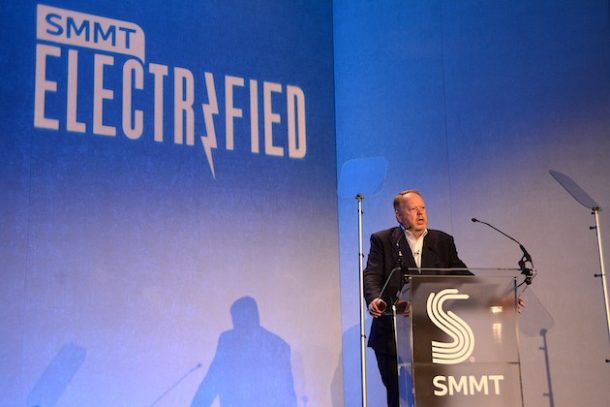
Industry Event Review: SMMT Electrified 2022 Conference Review – EV investment needed, now
“The UK government is investing in the EV sector but this is dwarfed by what we see in competing nations overseas. The field is already stacked against us. The UK needs four gigafactories in the next five years or it risks losing the entire automotive industry and its jobs. We need public and private sector investment. There’s not long to act before it’s too late.”
These are the words of Dr Andy Palmer, Chief Executive at Switch, at the 2022 SMMT Electrified Conference, who is now involved in the area of electric buses – although most people will know Andy from his time at Nissan, when, as COO, he presided over the UK launch of the LEAF (as well as more recently being Group CEO of Aston Martin Lagonda).
Andy added that we need targeted intervention by government, but the government should state the problem and the outcome required, and industry engineers should provide the solution.
Gigafactories, which manufacture EV batteries, are a perfect example of the investment needed in the EV sector. Different speakers claimed that the UK needs at least four gigafactories. The first one, Britishvolt’s site in the North East, has now been confirmed, and a second gigafactory is following. We need at least another two as soon as possible, along with ramping up the manufacture of other components in the EV supply chain such as electric motors – now.
MORE PUBLIC EV CHARGERS NEEDED
Just as the government needs to have a role in the investment for UK EV production, it also needs to have a role in UK EV charging infrastructure, and collaboration is equally essential here.
In the last two years, EV numbers have increased by 600%. In the same period the number of rapid charge points has increased by 80%.
Mike Hawes, Chief Executive, SMMT, said that for EV drivers, range anxiety used to be the issue, now charging anxiety is the issue. And chargers for commercial vehicles are almost non-existent.
At the moment, most EV owners charge their cars overnight at home. However one-third of UK homes don’t have a driveway, so when people in such properties buy an EV, they will be even more reliant on public charging. The SMMT would like to see the number of chargepoints increasing in proportion to the increase in EV sales.
There’s also a North-South charging divide. In London there are 9 EVs per charger. In the North West there are 55 EVs per charger.
A point was made that in China, local mayors have no choice but to support EV charging – which is not the case in the UK.
One area that has seen progress is the ability of EVs to charge at faster speeds. Although early EVs could only charge at a maximum of 50kW or 100kW, now cars such as the Kia EV6 can charge at 350kW thanks to its new 800v architecture, meaning that 62 miles of range can be added in just four and a half minutes.
Green Car Guide, having tested every EV that has ever been on sale in the UK for over ten years, regularly makes the point that was raised by a delegate at the event: although many drivers of EVs are likely to have had challenges over recent years with the UK’s public charging infrastructure, especially at motorway service areas, if you drive a Tesla, you have a completely different experience, due to Tesla’s investment in its excellent Supercharger network. There’s a lot of catching up to be done by everyone else.
EVS NEED TO BE MORE AFFORDABLE
Another key theme from the event was EV affordability. There have been, and still are, effective incentives for company car drivers, such as a very low Benefit in Kind tax rate. However the plug-in car grant has steadily been reduced for private buyers. Some comments at the event suggested that this reduction in the grant, following all the talk about Net Zero at COP26, wasn’t a good example of joined up government policy.
Leasing is seen to help to make EVs more affordable (reducing a £50,000 EV cash purchase to, for instance, £500 per month), and ‘bundled’ packages (such as including an EV lease with the supply of a home charge point) are seen to make it easier for consumers.
BATTERY PRICES ARE REDUCING
When the Nissan LEAF first went on sale ten years ago batteries cost $1,000 per kWh; today batteries cost $100 per kWh. One speaker said that the falling cost of lithium-ion batteries is seen to be ‘one of the most remarkable technology stories’. There was debate about whether the current rising lithium prices due to the situation with Russia would be reversing this downward price trend, but it was believed that long-term prices would still fall. It was also felt that we will have enough raw material supply for batteries.
ARE WE AT THE EV TIPPING POINT?
Paul Philpott, President and Chief Executive, Kia UK, believes that we’re beyond the tipping point. This is based on the huge proportion of orders placed for Kia EVs so far in 2022. We’re also in the position of residual values dropping for ICE cars, but residual values of Kia’s EVs are up 40%.
WHY IS EV INSURANCE MORE EXPENSIVE?
Speakers at the event confirmed that EVs are more expensive to insure than petrol and diesel cars. So why is this? Any damage to an EV’s battery – the most expensive part of an EV – means that it’s a write-off, as there’s no ability to repair or swap a battery.
Also, insurers need to get EVs repaired quickly (and cheaply) – but there are few technicians in the UK that can do this. It was agreed that a lot more needs to be done in the area of training and skills around EVs.
MOVING FROM TAILPIPE EMISSIONS TO TOTAL CO2 FOOTPRINT
EVs may have zero tailpipe emissions, but to get to Net Zero they need to be zero emission from a whole-life perspective.
We need to change the way we view how green cars are, moving from quoting tailpipe emissions to a vehicle’s total CO2 footprint – from manufacture, through use, to end of life recycling. For manufacturers to make truly greener vehicles, they need to massively cut the CO2 footprint of the supply chain.
One way to cut the CO2 footprint of an EV is to avoid shipping the car, and its components, around the world. This is especially true of batteries, which can weigh up to 500kg, hence the need for gigafactories in the UK. Local production and local supply chains would be much more sustainable. With rules of origin coming into play, this will also be cheaper. And the last few years have shown how supply chains from regions such as Asia can be disrupted.
Another key area is ensuring that all energy involved in EV and battery manufacture is green energy.
EV INFORMATION
How green an EV really is in terms of the total carbon footprint of the vehicle should be communicated on a car label, and this should include real-world driving ranges. Such a model already exists in the US, with a nine-box chart providing a variety of real-world range data. This label could also disclose the local content of the vehicle.
ELECTRIC HGVS – AND IS THE ELECTRICITY GRID GOING TO COPE?
Although progress has been made with electrifying cars and vans, this hasn’t been the case for HGVs, despite there being a looming ban on the sale of new internal combustion engine HGVs in the UK in 2040.
There were a number of different views about the potential for HGVs to be electrified, but the most common standpoint appeared to be that HGVs not travelling long distances could be battery electric, for example vehicles that carry out urban duty cycles such as refuse collection trucks, as well as those that aren’t weight constrained.
Aside from the manufacture of electric HGVs, another issue is charging them. The SMMT has identified various challenges with public infrastructure for electric cars, but the charging of HGVs is another story altogether: there was no awareness of one single public HGV chargepoint in the UK.
Logistics company Wincanton made the point that due to drivers’ hours regulations, drivers can’t wait in a queue to use a charger, and can’t wait for hours when charging. Yet there are no public chargers for HGVs at the moment, and the amount of infrastructure that would be needed to serve all the HGVs in the UK is huge, and this will take years to build.
Volvo believes that by 2040 most commercial vehicles will be electric – the company is launching its first 40 tonne battery electric truck very soon – with some long-haul trucks powered by hydrogen fuel cells. BEV HGVs will be able to use 750kW charging; if 1,000 trucks were charging at the same time, that would be 750MW – which is the same output as a nuclear reactor. Therefore, although it is believed the UK’s electricity grid can cope with charging electric cars, BEV HGVs are likely to be putting pressure on electricity grids globally.
There’s also the issue that the cost of getting grid connections for rapid chargers for cars can run into millions, never mind for HGVs.
CHINA, NIO, BATTERY SWAP
China was seen to have global ‘supremacy’ in EVs, due to the Chinese government leading on ensuring massive uptake, and also manufacturing the large numbers of EVs to ensure sufficient supply – showing that there can be rapid progress with EVs if governments play a leading role.
At the end of the event there was a presentation from Hui Zhang, Vice President, NIO Europe. The idea for the NIO brand was borne out of the problem of high levels of air pollution in China, with the result being a range of premium EVs that are due to feature 150kW solid state batteries and which can travel over 600 miles on one charge.
NIO has also developed ‘Battery As A Service’ (BAAS), involving battery swap technology: you drive your NIO into a battery swap station, an automated battery swap is completed within five minutes, and you can also upgrade your battery. The battery pack is also leased.
Another Chinese company, Geely, has a battery swap station for heavy cement trucks, which is seen as a potential solution if there isn’t a sufficient grid connection to rapidly charge HGVs in remote locations.
SUMMARY
For transport to play its part in achieving Net Zero – including rapidly ramping up UK EV production and ramping up the public charging infrastructure – one key action is needed: collaboration. Green Car Guide will continue to play its part in working with its partners to provide engaging and expert communication about EVs, as it has done for 16 years.
Paul Clarke
Automotive Comms & Green Car Guide





